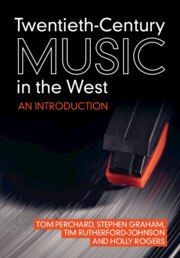Book contents
- Twentieth-Century Music in the West
- Twentieth-Century Music in the West
- Copyright page
- Contents
- Figures
- Tables
- Acknowledgements
- Introduction
- Part I Histories
- Part II Techniques and Technologies
- Part III Mediation
- Part IV Identities
- 13 Gender and Sexuality
- 14 Race and Ethnicity
- 15 Audiences, Class and Consumption
- 16 Centres and Peripheries
- Bibliography
- Index
16 - Centres and Peripheries
from Part IV - Identities
Published online by Cambridge University Press: 15 September 2022
- Twentieth-Century Music in the West
- Twentieth-Century Music in the West
- Copyright page
- Contents
- Figures
- Tables
- Acknowledgements
- Introduction
- Part I Histories
- Part II Techniques and Technologies
- Part III Mediation
- Part IV Identities
- 13 Gender and Sexuality
- 14 Race and Ethnicity
- 15 Audiences, Class and Consumption
- 16 Centres and Peripheries
- Bibliography
- Index
Summary
The concept of the ‘centre and periphery’ was a key one in twentieth-century music and culture. It took many forms: ‘mainstream and margins’ or ‘culture and counterculture’ oppositions; more personal ‘insider and outsider’ dynamics; and spatial relationships between centres of cultural power and their peripheries. This chapter examines such centre-and-periphery dynamics from a number of angles. It starts by tracking countercultures across the century, looking at the 1960s counterculture as a typical example in which competing values eventually become absorbed in the mainstream. The first case study surveys free jazz as a countercultural or marginal practice that largely managed to resist incorporation into the mainstream. The chapter then pivots to examine the insider and outsider dynamics inherent in noise music, where both aesthetic and social separation from the mainstream is prized as a core value. The second case study, on noise in Japan, extends and develops that discussion, examining the transnational dynamics that underpin even this obscure, marginal musical form. The chapter closes with a discussion of ‘downtown’ and ‘uptown’ music as a typical struggle between official and unofficial centres of musical power in the last decades of the century.
- Type
- Chapter
- Information
- Twentieth-Century Music in the WestAn Introduction, pp. 381 - 399Publisher: Cambridge University PressPrint publication year: 2022

